
Newsletter of the Shell Club of Sydney
NSW Branch, The Malacological Society of Australasia Limited ACN 067 894 848
Some of the topics inside:
1 Sydney Harbour Oil Spill - Hot News
1 Genus Fulgoraria
1 July Minutes
1 Shark Island Longitudinal Study
1 Australian private shell collections
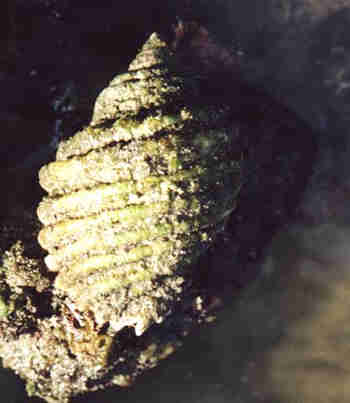
Dicathais orbita
South East sector of Shark Island Sydney Harbour.
Ten days after the Sydney Harbour oil spill
this live specimen is still struggling on, but is surrounded by an oil slick halo in the water below on right side of picture.


Fulgoraria rupestris
Fulgoraria rupestris

Fulgoraria mentiens

Fulgoraria clara

Fulgoraria niguchii, Fulgoraria clara

Fulgoraria elongata

Fulgoraria cancellata

Fulgoraria concinna

Fulgoraria hamillei

Fulgoraria angulosa
Genus Fulgoraria
Des Beechey, July shell club meeting presentation
(Steve Dean's interpretation)
During his presentation Des described each of the 22 documented species of Fulgoraria.
He marked up a map on the overhead projector showing the geographic range of each species. Most are from around Japan, with some from Korea, Taiwan, and now a new species from Vietnam
The depth range, shell size ranges and relative rarity were also tabulated.
Pictures of most species, and specimens were presented. Eight examples are shown in these ten photos.
Des gave his presentation in the form of an investigation to allow us to draw our own conclusions.
The conclusion reached by many was that a more detailed analysis might reveal that some of the species defined could just be variants in size and colouration of other species, related to habitat and depth.
Some of the factors that supported this line of thinking were:
- The distribution of many species is almost identical, with the only differentiator being the depth at which they live.
- Many of the species are of almost identical shape and colouring, except for size, again differentiated only by depth or geographic range
- Multiple specimens of individual species brought along by Des showed significant variation of shape and size approaching that of other species.
Fulgoraria are found over a wide range of latitudes (North of Japan to Vietnam) and over a wide range of depths (25m to 750m). They have been able to spread unhindered by deep oceans of the South China Sea, Philippine Sea and Sea of Japan, yet have not been noted elsewhere in the world. This distribution suggests that known, or yet to be discovered species may well exist in other areas, possibly including continental shelf regions around the Philippines, around China, and even to Malaysia.
July Minutes
Meeting opened P. Jansen at 2:02pm.
Field Trip Reports
A. Miskelly reported on a field trip to Bottle and Glass Rocks in Sydney Harbour. Ashley displayed an array of new photos to the meeting, including a dead collected
Fusus brazieri ( Angus, 1869 ). Ashley discussed a microscopic urchin found in shell grit at Vaucluse, and explained that this urchin species took the total he had collected in Sydney Harbour to thirty six.
M. Keats reported on an excursion to Shark Island on the 29/06/99. Michael was accompanied by A. Miskelly and representatives of National Parks and Wildlife. Michael mentioned the visit was disappointing and more detail would be given in a future presentation.
R. Moylan reported on a visit to the Yeppoon Shell Show, held a couple of weeks earlier. Ron mentioned that there were some great Thai shells available via Ion Eng. Ron added that this years' show was much smaller than last years' and its future could be in danger.
New Shell Acquisitions
A. Miskelly reported he had acquired a purple mouthed specimen of Amoria undulata
( Lamarck, 1804 ), given subspecific classification by some authors and known as
Amoria undulata angasii Sowerby1864. The shell had been collected near Port Lincoln S.A.
Book Reviews
P. Jansen informed the meeting that issues of La Conchiglia for the month had not been sent by the supplier and would, therefore, be late. Patty displayed "Swainsons Exotic Conchology" a new edition of an old book, presented in an old world style including print and plates. Other books Patty displayed were "The Mitridae Of The World", Turridae- Indo Pacific Mollusca, and Ranellidae and Personidae List Of Species.
General Business
Letter from Buff Netherton
A proposal was handed around the meeting by M. Keats. The six point proposal was put forward to decide on a course of action to deal with the trading surplus from The Second Australian National Shell Show Sydney.
After some questions and group discussion M. Keats proposal was unanimously adopted.
Presentations
Owen Griffiths from Mauritius gave a wonderful slide presentation on his recent visit to the Island of Madagascar. Owen's primary interests on the trip were land snails, though he managed to encounter some interesting marine shells via native villagers along the Mozambique Channel. A number of cave systems were explored and some interesting snail species found. Owen regaled the group with stories of the Radiata Tortoise, which is found in some numbers. Owen produced slides of a number of land snail species drawn up into spider webs to be used as homes by said spiders. Cultural differences were also noted. Considered a relatively poor people by world standards, it was quite amazing to learn that the natives could spend US$20,000 on a funeral. Owen answered a number of questions from the group and was offered a vote of thanks for his fine presentation.
D. Beechey gave a presentation on The Genus Fulgoraria using an overhead projector with transparencies and handing out copies of the maps and tables to the meeting. Des discussed the habitat and validity of species of the Genus Fulgoraria throughout Japan and the South China Sea, using depth of water as a parameter for restricting species distribution. We are left with the question: Is the Genus Fulgoraria currently undergoing speciation through isolation by depth of habitat? A vote of thanks was offered for Des' efforts.
The meeting was closed at 4.10pm.
C. Barnes, Secretary
A Longitudinal Study of the
Macro Molluscan Fauna of Shark Island
By Michael Keats
INTRODUCTION
In the mid 1980's the author commenced a survey of the macro mollusc fauna of Sydney Harbour.
The aim of the exercise was to produce a more an inventory of the mollusc fauna at all major shelling sites and to monitor the effects of harbour usage over time on species occurrence and survival.
Whilst Shark Island was not the first site to be studied, it is an important site, strategically located in the main harbour and protected to some extent by being accessible only by boat. No one site in the harbour is more important than any other but Shark Island has a better chance than most of protection from surface water runoff, salinity changes and turbidity. For this reason it was chosen for the first of the re visiting program
It is suspected that the mollusc fauna of Sydney Harbour is under considerable stress. The harbour is being used more than ever before for commercial and recreational use. Whilst a lot of industrial installations have been removed from the foreshores, the removal process has activated dormant deposits of heavy metals and other pollutants. Small oil spills are a daily occurrence.
The physical removal of wharfs and other structures around the foreshore has destabilised the harbour floor in many places. There is an increasing area of hard surfaces being built all the time in the catchment area of the harbour (roads, roofs, paved areas, etc).
These factors operating together have increased surface water flow, surface water speed of entry, water turbidity and locally reduced salinity after heavy rain. Fine material stays in suspension longer. Ageing sewer pipes are discharging coliforms such as E. coli and other bacteria into the upper water ways which feed into the harbour proper.
The resultant water quality whilst not necessarily toxic is challenging the more sensitive mollusc species for survival. As one species is reduced in numbers or becomes extinct there is a "knock on" effect on dependent species whether this as a food source or as a habitat.
Over an 8 year period the writer has surveyed most of the principal sites of the harbour and its two of its major tributaries, the Lane Cove River and the Parramatta River. The visit to Shark Island on the 29/6/99 is the first visit in the second cycle of monitoring.
BACKGROUND
In December 1994 systematic work commenced in developing a longitudinal study on the macro mollusc fauna of Shark Island in Sydney Harbour. The findings of the initial study were published in the "Sydney Sheller" April 1995. That study found that the total macro mollusc fauna of Shark Island comprised an estimated 104 species.
(The total number of species can never be precise. There will always be species which are itinerant and there will always be species which matter how thorough the survey will escape detection. This is confirmed in the current study. Breeding cycles can also influence the apparent living faunas depending on when sampling is undertaken.)
|
Species by category |
1994 alive |
1999 alive |
Variation |
1994dead |
1999 dead |
Variation |
1994 total |
1999 total |
Variation |
|
Gastropod species |
24 |
21 |
-3 |
57 |
49 |
-8 |
81 |
70 |
-11 |
|
Bivalve species |
2 |
4 |
2 |
19 |
15 |
-4 |
21 |
19 |
-2 |
|
Total Marine Species |
26 |
25 |
-1 |
76 |
64 |
-12 |
102 |
89 |
-13 |
|
Terrestrial species |
2 |
3 |
1 |
2 |
3 |
1 |
2 |
3 |
1 |
|
Total Mollusc species |
28 |
28 |
0 |
78 |
67 |
-11 |
104 |
92 |
-12 |
The material collected from the 1994 field survey is identified, and stored for future use and comparison as and when required.
The 1994 study had the benefit of reliable retrospective knowledge and data gleaned from field notes compiled by Kay Rutland since
1946 (Field note books compiled on areas around Sydney by Kay Rutland, amateur conchologist and member of the Royal Zoological Society of NSW 1946 - 1962 in the authors possession). This data was integrated into the report and the tabulations of species. This data also provided some evidence to plot the apparent disappearance of species which were previously extant around the island. For example
Umbraculum umbraculum was last recorded live on the rock platform in 1947.
The work undertaken in 1994 recommended the monitoring of the position every five (5) years. Informal discussions at the time with Dr. W. Ponder, Curator of Molluscs at the Australian Museum, also suggested there was some merit in visiting the Island at different seasons. For this reason the 1999 visit was made on 29/6/99 - the middle of the winter season.
All previous recorded visits by Rutland had been made during the summer season as this co- incided with the times that the Conchology Section of the Royal Zoological Society
(The section was disbanded by the RZS in its reconstruction in 1994)
held its Annual Picnic. Rutland's notes exclusively report on summer conditions and populations.
In the period between 1994 and the most recent visit, Sydney Harbour has been gazetted as an Inter tidal Protected Area by NSW Fisheries. There has also been a significant increase in interest in the harbour by a range of user groups. This interest has been into the quality of water and the biodiversity of the harbour generally.
The writer has participated in a number of workshops conducted by Consultants appointed by various authorities responsible for the administration of harbour affairs. The workshops have produced voluminous reports but little has been done to protect the mollusc fauna.
VISIT TO THE ISLAND ON 29/6/99
The National Parks and Wildlife Service is conducting a major exotic flora cleansing of the Island. There is systematic removal underway of all non-indigenious species. Presumably this will be followed by a replanting program of native species as closely as possible approximating the original flora.
The growth of exotic species such as Hedra (ivy) and various Aloes (succulents) has provided a safe but artificial habitat for two (2) identified species of native land snail. These are the Charopid,
Elsothera limula Legrande, 1871 and the Pupillid, Pupilla nelsoni
(Cox, 1864) . The presence of these species is especially marked on the S.E. corner of the island.
In June 1999 these two species exist in significant numbers. It is unknown whether the removal of the exotic plant species will result in the demise of these populations. It is suspected that in any event there would be a significant reduction in the populations.
The foreshores of the island now show visible evidence of increased human traffic and an increase in physical pollution. Macro items of rubbish (particularly plastics) were observed almost continuously around the island. The foreshore environment is significantly degraded relative to conditions which existed 5 years ago (1994).
The pressures of use on the island are constant. On the day of the study a boat load of school children arrived at the wharf, disembarked, raced around the island in less than 10 minutes and then re embarked and cruised away. In that short time they left an indelible impression of soil slips, flattened vegetation and food wrappers. It is not known how many such visits occur but the visual evidence suggests that it is frequent.
An area of the foreshore of particular interest to this study is the beach drift which flanks either side of the sandstone wharf at the southern end of the island. This drift provides an excellent monitor of the material which is living in the adjoining inter tidal area.
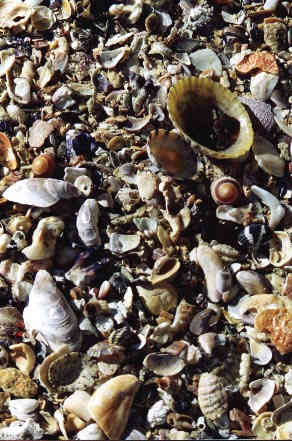
The most obvious observation is that the composition of the drift has "aged." This "ageing" is evidenced by the minimal addition of new, fresh dead material. It is further noted that the quantum of drift is much reduced and the material in it is overall, more degraded.
At a species level in this drift, many species which were found "fresh dead" in 1994 were either not represented or were represented by very worn almost indistinguishable fragments. Significant macro species included in this class are
Cymatium pathenopeum, Cymatium exaratum, Turbo torquata and
Turbo imperialis. This was later confirmed when inter tidal examination of the adjoining rock platform was undertaken.
Whilst the island is part of the Sydney Harbour Inter tidal Protected Area (IPA) this status has not protected the mollusc populations from apparent decline. Surface water runoff, pollution of various kinds and the pressure of shipping activities and human visits have all contributed to the current situation.
Many intertidal rocky areas of the south east rock platform were covered with a thin coating of silt and some were being covered with fine green weed. Many of the rocks below high water on the N.W. corner of the island appeared "bleached" even though the living mollusc fauna appeared quite healthy.
The observation of viable inter tidal mollusc species decline is unfortunately repeated at many other sampling sites in the Harbour. These include Cobblers Beach,
Wyargine Point (Balmoral), Chinaman's Beach (Articles by the author in the Sydney Sheller August 1997 and November - December 1997)
and Washaway Beach (Grotto Point) (Article by the author in the Sydney Sheller April 1998).
Live specimen sampling of the inter tidal area was undertaken on the S.E. rock platform. This platform is characterised by multiple micro environments including weed beds, sand areas, exposed rock platform areas and moveable rocks. The underside of some 30 moveable rocks were examined and returned after auditing the species present.
A defined 2m x 2m area of the weed beds was examined in detail. A similar area of exposed sand was also examined. The entire weed bed and sand areas were later examined for evidenced of any live molluscs.
The number of live species by major classification and environment around the whole island observed was as follows:-
|
Area |
Total number of live bivalve species1994 |
Total number of live bivalve species 1999 |
Variation |
Total number of live gastropod species1994 |
Total number of live gastropod species1999 |
Variation |
Total number of live mollusc species 1994 |
Total number of live mollusc species 1999 |
Variation |
|
Rock platform |
2 |
3 |
2 |
11 |
15 |
4 |
13 |
18 |
5 |
|
Under rocks |
- |
1 |
1 |
10 |
5 |
-5 |
10 |
6 |
-4 |
|
Weed beds |
- |
- |
- |
2 |
- |
-2 |
2 |
- |
-2 |
|
Sand areas |
- |
- |
- |
1 |
1 |
- |
1 |
1 |
- |
|
Total |
2 |
4 |
2 |
24 |
21 |
-3 |
26 |
25 |
-1 |
The significant trend emerging from the statistics is the decline in habitat quality in the weed beds and under moveable rocks. There is also an apparent improvement in the rocky platform habitat. This is evidenced by the increase in recorded species present on the day.
The weed beds would now appear to be almost devoid of molluscs. In the sand areas only one specimen of a living Naticid,
Natica gaulteriana was observed. No living bivalves were observed in the sand areas. The only living bivalve found under moveable rocks was an Arca species,
Barbatia pistachia. This specimen was juvenile and only observed.
Live species recorded in 1999 which were not previously recorded included
Turbo undulata (qty. 3) on the NW rock platform.
Dead species represented in the 1999 survey which were not recorded in 1994 include
Haliotis rubra ( 1 large dead specimen), Bullina lineata,
(fragment) and Conuber conica (worn, discoloured specimen)
Cypraea erosa (2 dead worn) and Parviterebra trilineata
( very worn). A fragment of the Pectinid, Pecten fumata, Reeve, 1852 was collected.
Species which were not represented in 1999 even as fragments included Nerita albilica, Clanculus brunneus, Phasianotrochus eximus, Clanculus clangulus, Clanculus maugeri, Fossarina patula, Australium kesteveni, Nodilittorina pyramidalis, Serpuloribis sipho, Cypraea flavoela, Polinices didyma, Charonia lampas rubicunda, Tonna chinensis, Tonna varigata, Epitonium jukesianum, Epitonium lyrum, Epitonium delicatulum, Pictobalcis articulata, Linaxis sertata, Aesopus pleurosulcatus, Ellobidae sp, Pupa fumata, Cardita excavata, Anodontia omissa, Fulvia tenuicostata, Hiatella australis,
A listing of all species represented in the 1999 audit follows.
List of macro-molluscs observed &/or collected on Shark Island 29/6/99
Prosobranchia
Docoglossa Acmaeidae - Patelloida latistrigata (Angas, 1865)
- Patelloida petterdi (Tenison Woods, 1876)
- Cellana tramoserica (Holten, 1802)
Patellidae - Patella chapmani Tenison Woods, 1876
Haliotidae - Halotis rubra Leach, 1814
Neritoidea Neritidae - Nerita atramentosa Reeve, 1855
Pleurotomarioidea Fissurellidae - Diodora lineata (Sowerby, 1835)
- Montfortula rugosa (Quoy & Gaimard, 1834)
- Tugali parmophoidea (Quoy & Gaimard, 1834)
- Scutus antipodes Montfort, 1810
Trochoidea Trochidae - Herpetopoma aspersa (Phillippi, 1846)
- Calthalotia comtessi (Iredale, 1931)
- Austrocochlea constricta (Lamarck, 1822)
- Austrocochlea concamerata (Wood, 1828)
- Clanculus floridus (Phillippi,1850)
- Stomatella impertusa (Burrow, 1825)
- Astele scitulum (Adams, 1854)
Turbinidae - Turbo torquatus Gmelin, 1791
- Turbo undulatus Lightfoot, 1786
Cerithiodea Cerithidae - Velacumantis australis (Quoy & Gaimard, 1854)
- Cacozeliana granarium Kiener, 1842
Planaxidae - Hinea brasiliana (Lamarck, 1822)
Littorinoidea Littorinidae - Bembicium auratum (Quoy & Gaimard, 1834)
- Bembicium nanum (Lamarck, 1822)
- Noddilittorina unifasciata Gray, 1826)
Truncatelloidea Rissoidae - Rissoina species
Vanikoroidea Hipponicidae - Antisabia foliacea (Quoy & Gaimard, 1835)
Calyptraeoidea Calyptraeidae - Crepidula aculeata (Gmelin, 1791)
Cypraeoidea Cypraeidae - Cypraea erosa Linneaus, 1758
Naticoidea Naticidae - Natica gaulteriana Recluz, 1844
- Polinices conicus (Lamarck, 1822)
Tonnoidea Ranellidae - Cabestana spengleri Perry, 1811
- Cymatium exaratum (Reeve, 1844)
- Cymatium pathenopeum (von Salis, 1793)
- Sassia parkinsonia (Perry, 1811)
Janthinoidea Epitoniidae - Opalia australis(Lamarck, 1822)
- Opalia granosa (Quoy & Gaimard, 1854)
Muricoidea Muricidae - Chichoreus denudatus (Perry, 1811)
- Lepsiella vinosa (Lamarck, 1822)
- Morula marginalba Blainville, 1832
- Dicathais orbita (Gmelin, 1791)
- Prototyphis angasi (Crosse, 1863)
- Agnewia tritoniformis (Blainville, 1832)
- Bedeva hanleyi (Angas, 1867)
- Cronia aurantica (Hombron & Jacquinot, 1835)
Buccinidae - Cominella eburnea (Reeve, 1846)
- Engina australis (Pease, 1871)
Nassariidae - Nassarius particeps (Hedley, 1915)
- Nassarius pauperus (Gould, 1850)
- Nassarius burchardi (Dunker in Phillipi, 1849)
Collumbellidae - Pseudomycla dermestoidea (Lamarck, 1822)
- Mitrella semiconvexa (Lamarck, 1822)
- Pyrene scripta (Lamarck, 1822)
- Parviterebra trilineata (A.Adams & Angas, 1863)
Mitridae - Mitra cooki Sowerby, 1874
Conoidea Turridae - Austrodrillia angasi (Crosse, 1865)
Conidae - Conus anemone Lamarck, 1810
Opistobranchia
Bullidae - Bulla botanica (Hedley, 1918)
Bullinidae - Bullina lineata (Gray, 1823)
Siphonariidae - Siphonaria diemensis (Quoy & Gaiimard, 1833)
Bivalvia
Arcidae - Babatia pistachia (Lamarck, 1822)
- Anadara trapezia (Deshayes, 1840)
Pectinidae - Chlamys livida Lamarck, 1819
- Pecten fumata Reeve, 1852
Ostreidae - Saxostrea commercialis Iredale & Roughly 1933
Anomiidae - Anomia descripta Iredale 1936
Mytilidae - Trichomya hirsuita (Lamarck, 1822)
- Mytilus planulatus (Lamarck, 1819)
Lucinidae - Codakia rugifera (Reeve, 1835)
Veneridae - Irus crenatus Lamarck, 1818
- Dosina sculpta Henley, 1845
- Tapes dorsatus (Lamarck, 1818)
Corbulidae - Corbula stolata (Iredale, 1930)
Tellinidae - Telina deltoidalis Lamarck, 1818
Mactridae - Spisula trigonella (Lamarck, 1819)
Cleidothaeridae - Cleidorthaerus albidus (Lamarck, 1819)
Limidae - Lima vulgaris (Link, 1807)
Hot News - Sydney Harbour Oil Spill
Editors note:
On 29th June Michael Keats conducted a longitudinal study of the macro molluscan fauna of Shark Island in Sydney Harbour. (His report appears
above)
The quantified results gave him the opportunity to clearly see if the oil spill and resulting cleanup had had any effect on the marine life around Shark Island.
He visited Shark Island 10 days after the spill, and his supplementary report follows.
The results are fascinating, especially considering how far down the harbour Shark Island is relative to the spill site.
The results do not bode well for marine life further up river closer to the spill site.
Supplementary Report Shark Island
By Michael Keats
On the night of 3/8/99 an oil tanker discharged some 300,000 litres of light crude oil into Sydney Harbour. The incident occurred at the Shell Terminal on the shore of Gore Cove some 3 km west of Sydney Harbour Bridge.
Although the authorities were swift in taking remedial measures including the installation of floating booms to control the spill, oil escaped and spread to a large portion of the harbour including the lower Parramatta River estuary and the harbour proper as far to the east as Shark Island.
The clean up operation was assisted by favourable weather conditions and the vast bulk of the oil was recovered. Despite this there was some damage to
water birds. In the immediate vicinity of the spill sea hares were beaching themselves presumably to try and avoid ingesting the oil.
Following the receipt of a copy of my report on the visit to Shark Island on 29/6/99 during the week of the spill, I received a call from a senior officer of the NSW National Parks and Wildlife Service Margaret Bailey asking whether I could visit Shark Island and provide an assessment of the spill on
molluscs.
An inspection of the Island foreshores was carried out on 13/8/99 to coincide with the afternoon low tide (.3m). Opportunity was also taken to show Service Officers the location of the habit of the two known species of land snail - the Charopid,
Elsothera limula and the Pupillid, Pupilla nelsoni. The comment was made that the location coincided with an Aboriginal midden and protection of the site would be assured.
Apart from the exotic plant species protection the midden would provide an on going source of calcium carbonate for the molluscs.
Systematic inspection of the Island was then carried out. Commencing at the Wharf at the Southern end of the Island I worked clockwise around the Island. Given the prevailing weather conditions the Service Officers surmised correctly that the Western side of the Island would show most impact from the spill. My attention was drawn to several spots where cleanup work had been undertaken.
The first impression is that the damage is superficial. On closer inspection the situation is more severe. Many oysters (Ostreidae) on the extended rock platform had died and the open white attached valves were conspicuous.
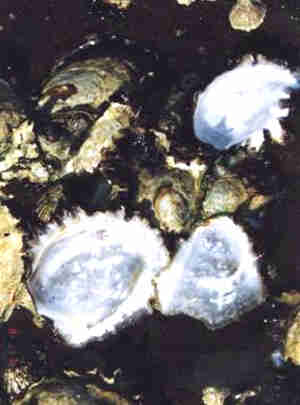
(Fresh dead oysters Ostrea commercialis rock platform south west side)
Limpets (Patellidae and Patelloididae) and False Limpets (Fissurellidae) appeared to be little affected although an examination of the beach wash showed a larger number than normal of fresh dead specimens.
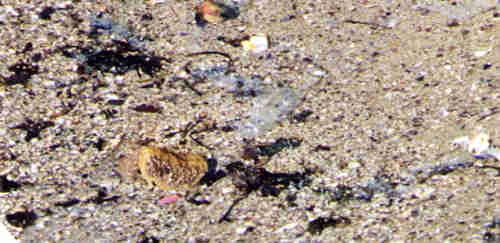
Beach wash and oil scum, Western side of landing wharf, Shark Island
Moving to the extended rock platform at the North Eastern end of the Island I was struck by the absence of any macro molluscs. Normally there would be whelks (Ranellidae) and turbans (Turbinidae). Except for one live
Turbo undulatus, which was in a favoured position, there was nothing at all.
The cunjevoi and seaweeds were all coated with an iridescent sheen. A manual examination of a purple sponge at a depth of .5 m showed it to be oily to touch and discoloured in places.

Mauve sponge through 0.5m of water, North West side of Shark Is. Showing discolouration
There were no living specimens of Scutus antipodes, which was common in the area on 29/6/99.
The Eastern side of the Island was then examined. Here the marine life was generally in better shape and a number of living molluscs were observed. The seaweeds, sponges and polychelate worms appeared normal.
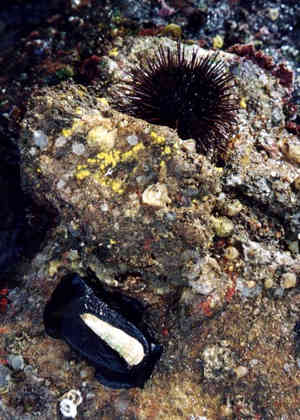
Underside of rock, Eastern side

Live Lima minbifer, Tungali parmophoidea, Clangulus fliridus,
Chronia aurantica Eastern Side
Moving to the South Eastern complex micro-environments the condition of the area deteriorated relative to the Eastern side. Significantly there were a number of relatively uncommon species fresh dead in shallow water. These included mature specimens of
Cypraea caputserpentis, Cypraea moneta and Strombus mutabilis.
The presence of these species was not unexpected, but it is very unusual for them to be fresh dead, in shallow water and in perfect condition. It is not unreasonable to suspect that there is a relationship between the oil spill and their demise.
The situation is such that further monitoring of the mollusc fauna will need to be carried out regular intervals for at least 12 months to determine the long-term effects and whether permanent damage has been done to the marine mollusc fauna.
Major Australian shell collections
By Kev Lamprell
Dear Steve, I read with interest your item on the Lorna Marrow collection, and as an infrequent visitor to the collection I thought I could add some items of interest to the article.
The Marrow collection started with Lorna collecting shells as a very young girl in Queensland and has continued throughout her life to the present time. After her marriage she and her late husband Ivan had numerous trips around Australia extending as far as north Cape Leveque in Western Australia, Darwin and Queensland as well as overseas collecting shells and other marine fauna, in addition "trading" with overseas collectors has added many specimens to the collection.
This fieldwork has resulted in a very large and extremely comprehensive molluscan collection, which needed adequate housing. Ivan (Lorna's late husband) being an Architect designed a large work room and security area for the specimens which is jokingly referred to as the vault which consists of two walls completed lined with drawers specially designed to
accommodate the collection.
To compliment this large collection an equally comprehensive library is available in the adjoining shell room with work areas and microscope. The cataloguing of the specimens is also of great interest, the specimens each are numbered in Indian ink, the number recorded in a catalogue and, more recently electronically in a computer.
Lorna and Ivan's son Max, is himself an accomplished malacologist his primary interest is in the Mitredae and Turridae in which fields he is an acknowledged expert. His collection is also now housed in separate cabinets in the working area.
Another collection of great scientific importance in Australia is the Thora Whitehead collection in Brisbane. Like Lorna, Thora started collecting as a young girl in Africa and continued after her arrival here in Australia.
This collecting combined with an extremely retentive mind has resulted in a very large, extremely interesting and comprehensive collection of marine molluscs both in the Gastropoda and Bivalvia. Thora's library is equal to the collection size with bound volumes, reprints or photocopies of every imaginable publication, many extremely rare.
Both of these very valuable and important collections are notable for their excellent representation of species within the different families and are complete with full collecting data and easy access. Of interest is that there is no accent on "gem" quality specimens. Variations of the various species have been selected for ease of identification rather than beauty. The collecting of "gem" specimens is frowned on by many of the more serious collectors who consider that it leads to too much commercialism and over collecting to the detriment of our hobby.
Lorna and Thora both take an active role in various shell clubs and do a great public service by entertaining serious overseas and local enthusiasts who wish to examine our molluscan fauna.
|

















